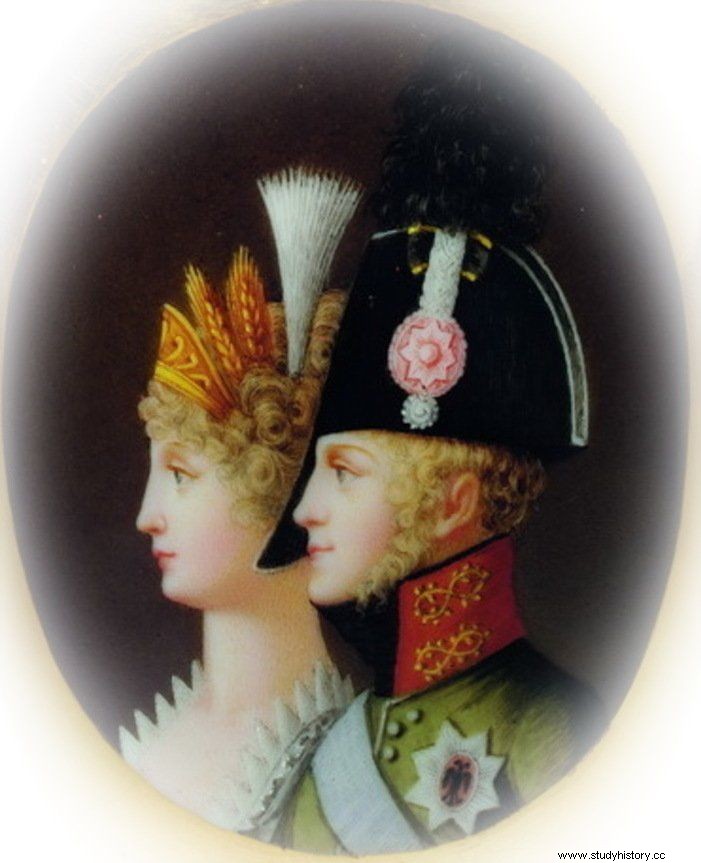The ruler should be a model of virtues and set a moral example? Certainly not in Russia! A different lover every day. A monarch announcing that she feels like a "cat in heat". And official, court breeders. This is the intimate life of the empresses of the East.
From the end of the 17th century to the beginning of the 19th century, Russia's fate was in the hands of dissolute women. What was at the root of their twisted temperaments? A deformed perception of the idea of enlightenment? Choking on absolute power? It's hard to tell, but their exploits have gone down in history.
Patriarch's son on the throne?
In 1672, Russia celebrated the birth of the handsome Tsarevich Peter, the future Peter the Great. There was only one fact that spoiled the festive mood. This son of the ruler from the second marriage was strong and healthy, unlike the rickety descendants of the previous marriage. And this raised serious doubts about paternity ... 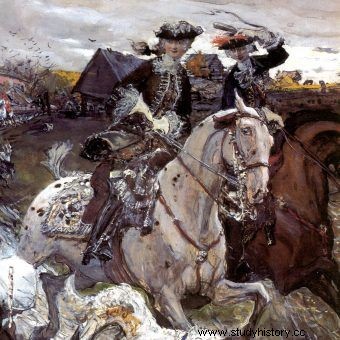
Natalia, Piotr's young mother, was not famous for her faithfulness. Some noted that she spends a lot of time with the tall patriarch of the Moscow church, and suspected that she had become pregnant during the "catechesis". Others believed that the tsar was fathered by an eminent young man, Tikhon Striesznev.
Piotr, unlike anyone else in the family, reportedly purred the subject. When he directly asked Tikhon if he was his son, he heard, "I don't know, I wasn't the only one."
French aristocrat from the stud
If anyone thinks that the habits of Peter's half-siblings were more prudish, they are seriously mistaken. His sister Zofia, regent and de facto ruler of Russia for many years, played with Vasyl Golitsyn, whom she called the sun. She even gave him a triumphant greeting when he returned from a war campaign that ended in a complete flop.
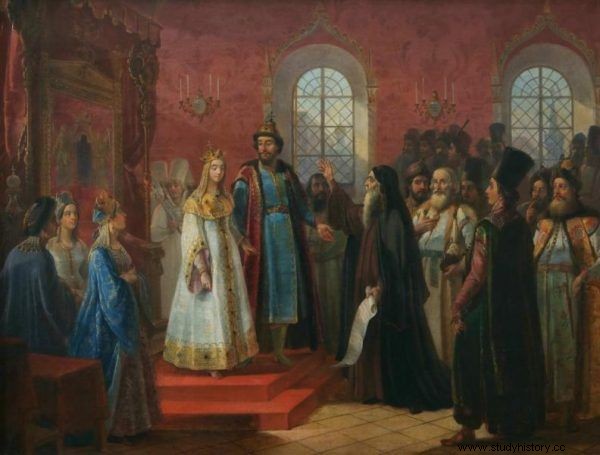
Celebrations on the occasion of the Tsarevich's birth are going on, only the mother is so pensive ... Has she been wondering who the daddy is? Image by W.K. Demidow from 1846 entitled "Birth of Peter I" (source:public domain).
Zofia had high hopes for her own brother, Ivan V, who was handicapped both physically and mentally. For five years after their marriage, Ivan's wife was childless ... and then she gave birth to five daughters, almost year after year. Miracle? Rather hard work of Juszko, a sire found by Zofia. The regent preferred to see her sister-in-law's bastard on the throne, rather than her unpopular half-brother - Piotr.
Decades later, one of Ivan V's (alleged) daughters, Anna, was unexpectedly invited to take over the Russian throne. The ten-year reign has been dominated by one favorite… and many lovers.
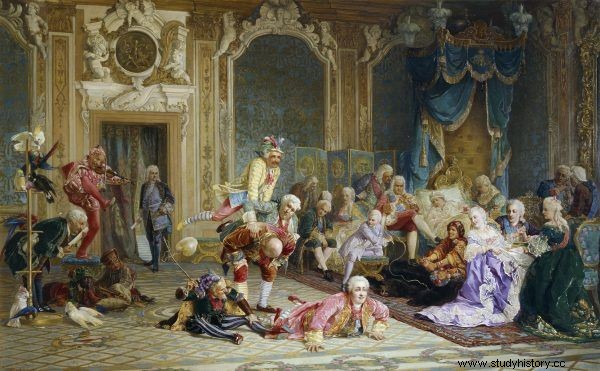
The Tsarina Anna made sure that her surroundings were very cheerful ... The painting by Valery Jakobi "The Fairy at the Court of Empress Anna Joannowna" from 1872 (source:public domain).
Anna, newly married, quickly became a widow. Thirsty for love, she decided to take a lover. First she found consolation in the arms of Piotr Bestużew-Ryumin, and then Ernest von Bühren.
Ernest was the son of a groom, but he preferred to be referred to as Biron, implying an affinity to the French magnates of the surname. When Anna became a tsarina, he was promoted to the ruler of Russia by her side. As Michael Farquahar writes in the book "Secrets of the Tsars. Intrigues, scandals and crimes of the Romanovs ":
Neither of them could hide their feelings (...). When the prince came scowling, the empress's face was immediately concerned. If he was happy, her face was happy too. Who did not manage to satisfy the prince, had to reckon with an unfavorable gaze and acceptance from the monarch.
A lover's head in a jar
Peter the Great's women weren't any better. The tsar married a peasant girl, a former marquetry girl, Marta, who, after converting to Orthodoxy, took the name of Katarzyna. Their relationship began with the fact that Piotr ... took the chosen one from his friend, Alexander Menshikov.
Already as the wife of the Tsar, Catherine did not avoid romances. Despite her discretion, someone "friendly" informed Piotr about his wife's extra-curricular games with a certain Wilhelm Mons. The monarch's anger was great.
Mons - officially for bribery - was shortened by a head. After the execution, Piotr took his wife on a tour of the blood-drenched place of execution so that she could see the corpse of lovelas. Soon she was in for an even more "pleasant" surprise - her husband presented her with a jar with Wilhelm's head preserved in alcohol inside.
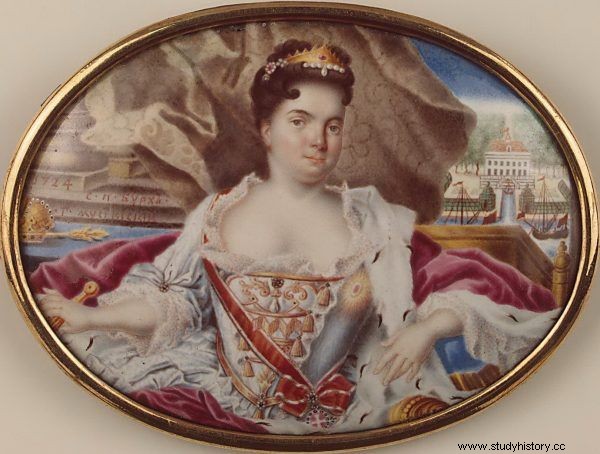
Catherine I's life was like a merry-go-round. She almost lost it all by her affair with Mons, and then… became ruler of all Russia! A miniature of Grigory Musikijski from 1724 - the same year in which William lost his head to the empress (source:public domain).
Fate smiled at the terrified Katarzyna. Piotr died 2 months after the scandal, and Menshikov raised his former concubine to the throne.
Taking advantage of the gained position, the tsarina invited more and more young men to her bed and organized nightly orgies that often lasted until dawn. The Polish count Piotr Sapieha often visited them, rewarded with jewelry and bouquets.
Like mother, such daughters
Catherine I and Peter I had two daughters:Anna and Elizabeth. And both of them definitely fell into their mother…
Anna, unhappy in her marriage, died shortly after the birth of her only son. His father was probably Colonel Bruhmer, who later became the boy's tutor.
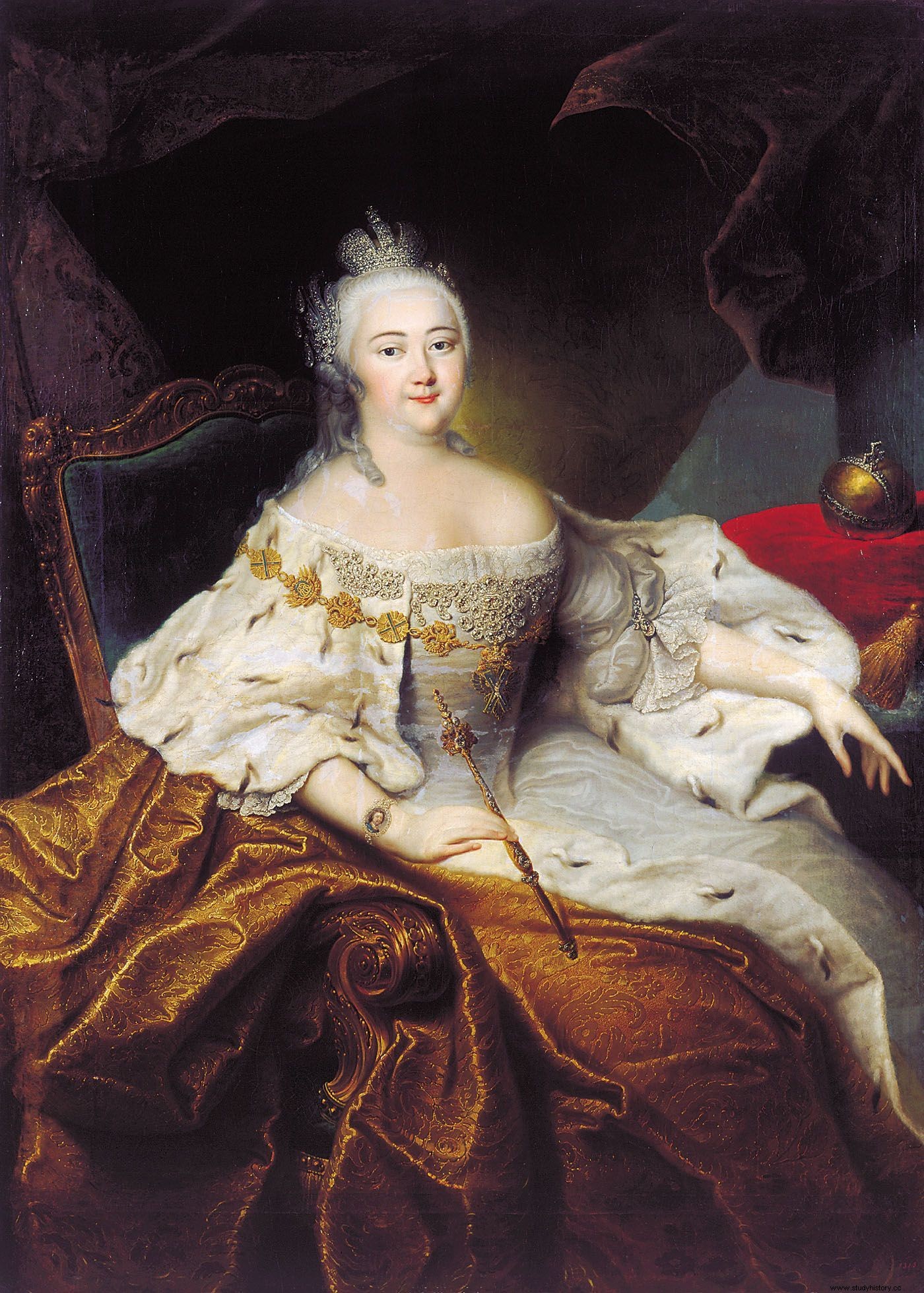
An old maid - yes. Virgin - absolutely not! Tsarina Elizabeth I enjoyed the pleasures of the bed from her early youth until her death. 18th century portrait by Georg Christoph Grooth (source:public domain).
Elizabeth remained an old maid. But it had nothing to do with virginity. As a teenager, she corrupted her close relative, the still adolescent Tsar Peter II, and then she got into an affair with Peter's friend, Szymon Naryshkin.
Shortly after the death of Peter II, Elżbieta met Aleksy Razumowski, a Cossack son, who sang in the court choir. The Ukrainian took a permanent place in her heart - even after she became the ruler of the entire empire. Still, the soda didn't go to his head. As Michael Farquahar writes:
Unlike other imperial lovers (...), Razumowski avoided the privileges and high dignities with which he was showered by a loving Elizabeth. "Your Majesty, if she so wishes, can even make me a field marshal," Razumowski once told her, "but I doubt that anyone could even make me a middle-class captain."
Apparently, the lovers secretly married at the beginning of her reign. Of course, this was no obstacle for Elizabeth to invite other gentlemen to her bed. Ivan Shuvalov, a beautiful and educated lover of France who persuaded the Tsarina to establish two universities, visited it very often.
A betrayal for the sake of the family?
Elizabeth appointed her only nephew, the future Peter III, as heir. The boy turned out to be useless - he couldn't even beget an heir.
His wife Catherine, after several years of a sterile relationship, devoted herself to the seducer Sergiusz Sałtykow. The tsarina Elizabeth seemed to tolerate and even approve of her lover. She wanted an heir so badly that she didn't care who would father him.
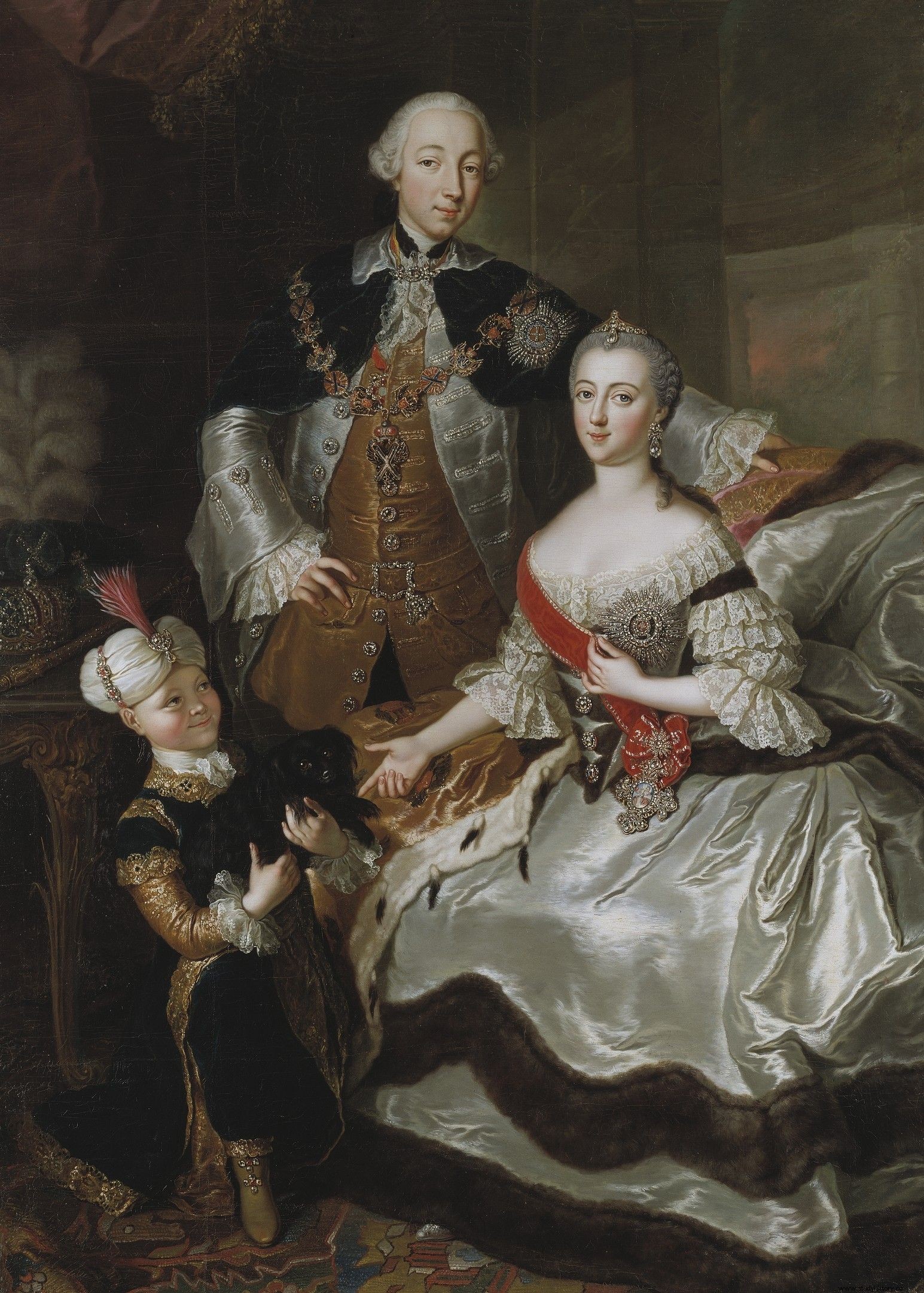
Paweł, Piotr and Katarzyna. Happy family? More like a bastard, cuckold and a harlot! Picture by Anna Rosina Lisiewska from 1756 (source:public domain).
Sergius fulfilled his task - Catherine gave birth to a son, Paul - and was sent to Sweden. The young woman, having discovered the pleasures of the bed, did not want to give up on them, however. Among her lovers was, for example, the future Polish king Stanisław Poniatowski. Another, Lev Naryshkin, felt so confident that…. he was meowing under her bedroom for her to let him in.
A cat in heat on the throne
In 1762, as a result of a coup d'état carried out mainly by her lover Grzegorz Orłów and his four brothers, Katarzyna became the Tsarina Catherine II. The handsome and graceful Orlov became her official favorite - the first of ten. Not counting fleeting romances, of course.
The one-eyed colossus, bright Grzegorz Potemkin, occupied a special place among the favorites. Perhaps he became the husband of the tsarina - and he certainly was her constant associate and almost co-ruler. He aroused powerful emotions in Katarzyna. In "Secrets of the Tsars" we read that:
The forty-five-year-old empress, the most powerful woman in the world, has completely lost her head to Potemkin. She invented a whole arsenal of caressing names for him, such as:"golden hen", "nice toy", "expensive mascot", "soul mate", "favorite doll" (...).
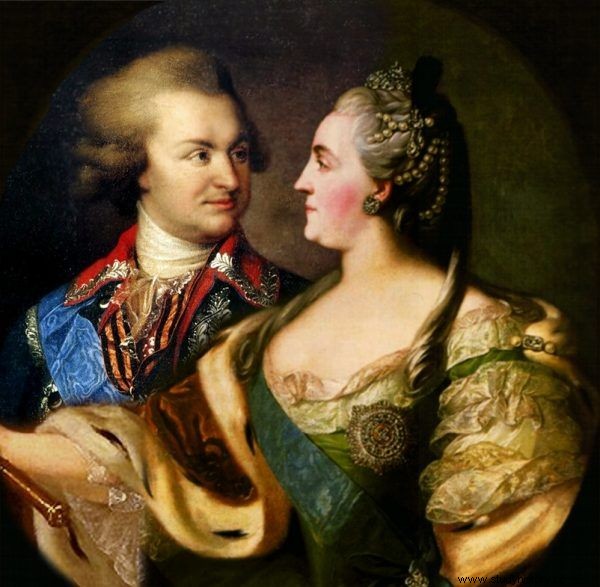
"Golden Pheasant" and his "hot woman" in a contemporary collage of Potemkin's portrait by Lampi and Catherine II by Fyodor Rokotov (photo:Shakko, license CC BY-SA 3.0).
In her letters, she confided to him, among other things, that she felt with him "like a cat in heat" and called him "a lion in the jungle". The violent passion quickly faded, and the former lover began pimping her further prey.
She treated some of her partners as sons - after the death of the sympathetic Łanski, who had been exhausted by the means for potency, she despaired for almost a year. The last favorite, Platon Zubov, was 38 years younger than the Tsarina. And with an enormous shoe, he used his position at court. As Michael Farquahar writes:
Every day from eight in the morning, ministers, courtiers, generals, MPs, petitioners, people seeking appointments and promotions (...) were crowded in the vestibule. Typically they had to wait four to five hours before being admitted. (…)
Having waited so much time outside the door, the petitioners were overjoyed to see the Capuchin monkey Zubov, who was screaming around the room and sparkling their hair. / em>
Catherine II married her son with Wilhelmina Hesse (after converting to Orthodoxy:Natalia). The girl was escorted to Russia by a friend of the heir to the throne, Andrzej Razumowski. And she liked it with reciprocity. Probably only Paweł did not know about it. When Natalia died in childbirth, as we read in "Secrets of the Tsars": The husband she was pissing the horns into was madly in despair, smashed furniture in his rooms and threatened to jump out of the window. (...) In the end, the empress put an end to these quirks and told her son the painful truth about her deceased wife, and as evidence showed the love letters from Razumowski, which she found in Natalia's desk.
She is blonde, he is blonde, and the child is dark-haired. An order of almighty God, or maybe Czartoryski's activity? A miniature of Elizabeth and Alexander I from the 19th century (source:public domain).
It was only with his second wife that Paweł had a successor, Alexander. When he was 15, his grandmother associated him with the fourteen-year-old Louise of Baden, better known by the Orthodox name Elizabeth. Aleksander quickly condemned his wife to a "friendzona", seeking satisfaction in his lover's arms.
Aleksander decided to make it up to her somehow by inviting his friend, a Pole, Adam Jerzy Czartoryski, to her bedside! Soon Elżbieta gave birth to a baby girl. She explained the dark hair and eyes of the child of fair-haired parents to her mother-in-law with the words:"God is almighty ..." The romance ended with exile for Czartoryski to a foreign post.
Later, Elizabeth happened to give birth to another daughter, probably born by Alexei Ochotnikov. Both girls died young and the spouses got closer to each other only in old age. Friend, take my wife
